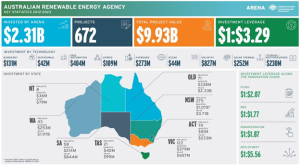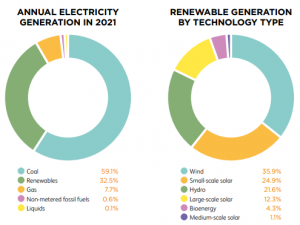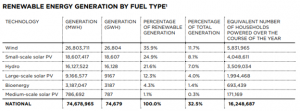Australia
Renewable Energy Investment in Australia
The Australian Renewable Energy Agency (ARENA) outlines Australia’s renewable energy investment strategy in its document entitled Innovating Energy: ARENA’s Investment Plan (2021). ARENA’s Strategic priorities include:
Priority 1: Optimize the transition to renewable electricity
Priority 2: Commercialize clean hydrogen
Priority 3: Support the transition to low emissions metals (steel, aluminum)
Priority 4: Explore opportunities to scale up carbon capture and storage (CCS) and reduce the cost of soil carbon measurement
Priority 5: Deliver the targeted programs in the 2020-21 Federal Budget.[1]
ARENA has supported 663 projects since 2012 by providing $2.25 billion in grant funding, with a total investment of nearly $9.75 billion in Australia’s renewable energy industry.[2] These renewable energy projects have supported the development and commercialization of technologies related to bioenergy, geothermal energy, grid integration, hybrid solutions, hydrogen, ocean power, solar PV, solar thermal, and energy storage and battery technologies.[3]

Source: ARENA, 2023[4]
Renewable Energy Generation
According to the Clean Energy Australia Report 2022, the Australian renewable energy industry accounted for 32.5 per cent of Australia’s total electricity generation in 2021, representing an increase of nearly 5 percentage points as compared to 2020. The proportion of Australia’s electricity that comes from renewables in the past five years has almost doubled, increasing from 16.9 percent in 2017 to 32.5 percent in 2021. Some of Australia’s largest wind and solar projects were completed in 2021, which included the country’s three largest solar farms and two of its three largest wind farms. At the end of 2021, a further 68 large-scale projects were under construction or financially committed, representing more than 9 GW of new capacity and over $18 billion of investment. Of these 68 upcoming projects, 42 are solar farms, 19 are wind farms, three are bioenergy projects, two are hydropower projects, and two are hybrid wind and solar projects. [4]

Source: Clean Energy Council, 2022 [5]

Source: Clean Energy Council, 2022[6]
What Are Australia's Goals for Renewable Energy?
The Australian Government has implemented the Renewable Energy Target (RET) scheme, which is comprised of two schemes: 1) the Large-scale Renewable Energy Target (LRET), which incentivizes investment in renewable energy power stations (i.e., wind and solar farms, and hydro-electric power stations); and the 2) Small-scale Renewable Energy Scheme (SRES), which incentivizes households and businesses to install small-scale renewable energy systems (i.e., rooftop solar panels, solar water heaters, small-scale wind or hydro systems). The LRET aims to deliver 33,000 gigawatt hours of extra renewable electricity each year, and is currently expected to remain at 33,000 GWh until the scheme ends in 2030.[7]
The RET scheme has been amended several times. The history of the RET scheme, new targets, and legislation aimed at achieving their goals is described in further detail here.
Updated by Erin George, December 2023

Comments are closed.